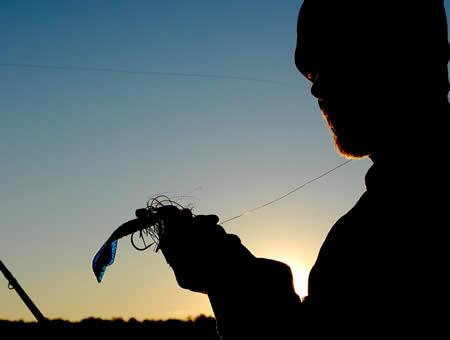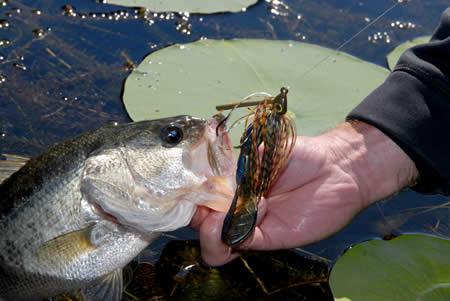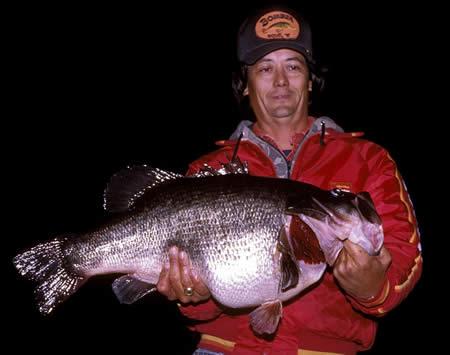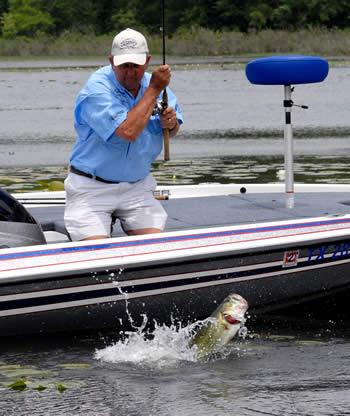
February 24, 2018 - There are a passel of lures that will catch a bass, but none will fool the big ones with more consistency than a jig will.
Some of Texas' heaviest bass have been caught on jigs, including the former state record hauled in at Lake Fork in Nov.1986 by Lake Fork guide Mark Stevenson. Stevenson's 17.67 pounder ate a 1/2 ounce black/brown/pink Stanley Jig dressed with a plum crawdad trailer. The fish was holed up in a bush located on a small point that formed where the main channel intersected with a smaller secondary channel. The water was about 14 feet deep on the creek bank and 22 feet deep in the channel bed.
Nobody knows for certain what happened down there amid the watery jungle of mangled cover, but it's pretty obvious the big bass couldn't resist the temptation of the artificial lure when it came creeping by.
So, what is it about the jig that makes it so deadly on heavyweight bass? I looked to veteran jig maker Lonnie Stanley of Huntington for some answers.
"There are a lot of baits that imitate crawfish, but none of them do it better than a jig does," said Stanley. "It moves across the bottom really slow, has pretty large profile and it penetrates the heavy cover where big bass like to hang out extremely well."
The Anatomy of a Jig
There's nothing complicated about the anatomy of the bait. It consists of a lead head molded around a hook that is usually protected by some sort of weed guard to help the bait get in and out of logs, limbs and grass without fouling or hanging up. The hook is hidden beneath a living rubber or silicone skirt that undulates with the bait's every move.
Most anglers like to outfit the jig with some sort of plastic trailer to enhance the action, create an even larger profile and cause the bait to move more water. A trailer also can make a bait more buoyant and slow the fall rate to a degree.

Different Styles
Like other families of lures, jigs have undergone some big time changes over the years. Back in the 1970s, when rubber-skirted jigs started gaining popularity, there were limited designs available for performing a broad range of techniques.
"Back in the early days, Larry Nixon, Tommy Martin and myself used the same jig to fish around creeks and brush that we used to swim around shallow grass and lotus pads," Stanley said. "We we didn't have all the different jigs and head designs that we have now. Things are a lot more specialized now. There are jigs for all sorts of different techniques."
Flipping Jigs
Flipping jigs are made for fishing in or around heavy cover like grass, bushes, brush, log jams, etc…. because they are designed with a slender, compact head and stiff weed guard that allows for getting in and out of thick stuff like grass and brush without hanging up. The best ones will have heavy duty hook to withstand violent hook sets at short range when using heavy action rods and stout braid or fluorocarbon lines with limited stretch.
Flipping jigs some in assorted sizes but those ranging 3/8 to 1 ounce will generally cover most of the bases. Lightweight jigs sometimes work best in cold water because they provide a slower fall that may appeal more to lethargic bass suspended in the water column.
Grass Jigs
Grass jigs are made for probing grass beds like hydrilla or milfoil. As such, the head is somewhat conical in shape so it can slip in and out of of grass mats easily. It should have heavy wire hook that won't bend.
Grass jigs come in assorted sizes. Many anglers prefer jigs weighing upwards of 1 ounce to optimize efficiency with a vertical presentation. Most strikes occur out of reaction, usually on the fall, but not always. Once the jig reaches bottom, hop it a couple of times, reel in and repeat the process.

Swim Jigs
Swim jigs are a good choice around shallow grass and bushes. Unlike grass and flipping jigs, swim jigs are intended to be fished at steady or staggered retrieve -- similar to a spinnerbait or crankbait.
The swim jig head has a bullet-shaped head to help it snake through heavy cover without hanging up and a really stout hook. It comes in assorted sizes; 3/8 ounce is the all-around favorite. The best color patterns for swim jigs are bluegill, black/blue and white.
Football Jigs
The football jig works best on hard bottoms with pea gravel, chunk rock, small boulders or scattered brush and stumps, especially when the fish are feeding heavily on crawfish.
It has a fat, football-shaped head that helps prevent the bait from falling into crevices or cracks that might snag other jig styles. It can be effective when dragged on bottom like a Carolina rig or "stroked" to make it hop. Performs best in combination with some sort of color coordinated trailer like a grub, creature or craw.
Bladed Jigs
The bladed jig is designed similar to the swim jig, with addition of a flat, metal blade that pivots on the line tie. The blade catches water and creates resistance, causing the bait to shutter side-to-side as it moves through the water column. This causes the skirt and trailer to undulate wildly while creating vibration to help the fish home in on the bait from a distance.
It's a great choice when fishing around shallow grass, bushes or brush. It's designed to be worked on a steady retrieve and does not have a weed guard, so you have to be careful when casting into areas with heavy brush.

The bait can be fished with or without a trailer. Small swim baits like the Lake Fork Magic Shad make great trailers.The Magic Shad has broken sides and is ultra-responsive to the vibrating action. You can trim the jig skirt about an inch long or remove it altogether when using a swim bait trailer to alter the appearance and change the action.
Jigs don't always work, but when they do they will catch some of the biggest bass in the lake.
Matt Williams is freelance writer based in Nacogdoches. He can be reached by e-mail, mattwillwrite4u@yahoo.com.








